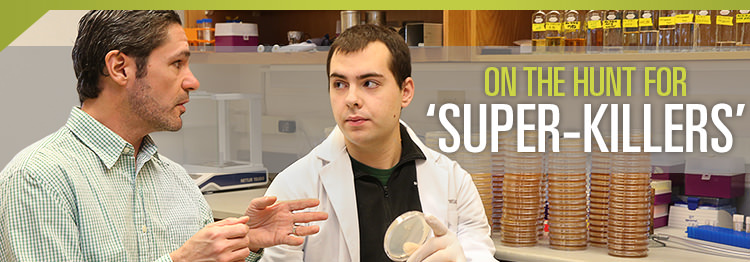On the hunt for 'super-killers'
Marine bacteria may prove source for new antibiotics

Dr. Hans Wildschutte and junior biology major Alex Antel
Survival is the name of the game even among marine bacteria, research by BGSU biologist Dr. Hans Wildschutte shows. In the competition for food, some have genetically adapted to become "super-killers," able to fend off other unrelated populations of bacteria in their area while remaining "friendly" toward closer relatives.
Although the Vibrio bacteria he studies are nonpathenogenic to humans, the survival mechanisms they have developed show promise as the basis for new antibiotics with therapeutic properties, said Wildschutte, whose work was featured in the leading journal Science last fall.
The rise of antibiotic-resistant bacteria has become a growing and dangerous problem and of great concern to the medical community, especially in the United States.
"Novel antibiotics could be useful in the treatment of illness caused by gram negative bacteria," which can be resistant to many available antibiotics, Wildschutte said. His work is funded by a three-year, $300,000 grant from the National Institutes of Health.
"It's really exciting to be working in the lab with strains of bacteria that no one has really studied before and, especially as an undergraduate, to be part of something like this."The Science article, "Ecological Populations of Bacteria Act as Socially Cohesive Units of Antibiotic Production and Resistance," details the initial findings that natural antibiotics produced by some Vibrio bacteria strains may effect competition between populations instead of simply increasing the success of individuals.
As a postdoctoral researcher at MIT before joining the BGSU faculty, Wildschutte was part of a team that developed tools for genetically manipulating environmental organisms. This meant that, for the first time, wild strains could be cultured in the lab and mutated in order to study how they might function as social units in the wild, or if they even did function as part of a social structure instead of strictly as individuals.
The marine environment can be depleted in nutrients, so the ability to acquire food is important for survival, Wildschutte said. Vibrio are ubiquitous and can be found free-living in the water column, on the surfaces of zooplankton, associated with suspended particles and in the organs of animals such as fish and crabs. "These habitats represent carbon resources, which bacteria may compete for in their environments," Wildschutte explained.
To identify a "super-killer," environmental Vibrio strains are cultured and spotted on a plate spread with another Vibrio isolate. A zone of clearing shows that one strain inhibits the growth of another. Two hundred strains were tested, yielding a pairwise analysis of 40,000 interactions. Only seven isolates were identified as "super-killers."
Computational analysis performed by Otto Cordero at MIT comparing inhibition and genetic relatedness showed that killing occurred more frequently among unrelated Vibrio, while closer relatives were resistant.
Wildschutte is now performing research to identify genes that encode the antimicrobial factors. He and his students are improving methods to identify mutants that have lost the ability to kill other bacteria. Using this optimized method, a search of 20,000 bacteria is predicted to yield about 20 that no longer antagonize. These mutants are used to identify the genes that encode antimicrobial factors.
"We're looking for the correlation between the 'super-killers,' which kill the most strains, and those being killed. We're not sure of the antagonistic mechanism," Wildschutte said, referring to the bacteria's deadly action. "They may secrete a compound that causes a pore to form on the surface of other bacteria. We're also looking at the method of resistance among strains."
The research requires motivation as many methods turn out not to work, "but then you find one or two things that are new," said Alex Antel, a junior from Parma, Ohio, majoring in biology, who has worked in the Wildschutte lab for about a year. "It's really exciting to be working in the lab with strains of bacteria that no one has really studied before and, especially as an undergraduate, to be part of something like this."
Their analyses so far show only a minority of Vibrios exhibit antagonistic activity among more distantly related strains. "We want to know what genes encode the antimicrobial factors among the identified 'super-killers,'" Wildschutte said. "The environment provides a source of undiscovered products."
Wildschutte has adapted this research methodology, in collaboration with Drs. Michael McKay and Goerge Bullerjahn, at BGSU in order to study important microbial processes among freshwater bacteria within the Great Lakes. Ongoing research involves diverse bacterial interactions that can be probed for a range of factors from novel antimicrobial products to new alternative energy sources.
Updated: 12/02/2017 12:54AM
